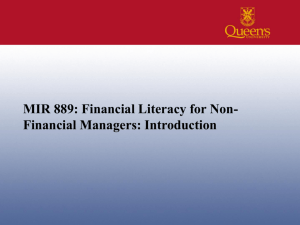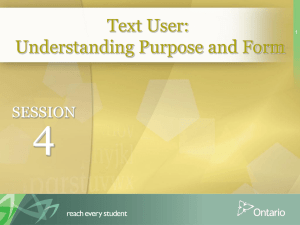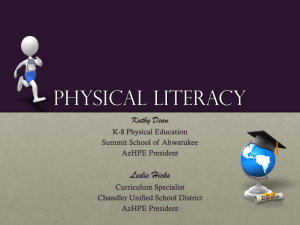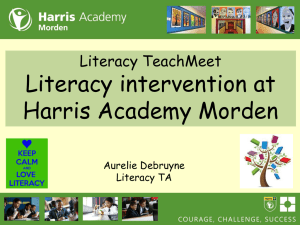Lecture: First Session, 10 September 2014
advertisement
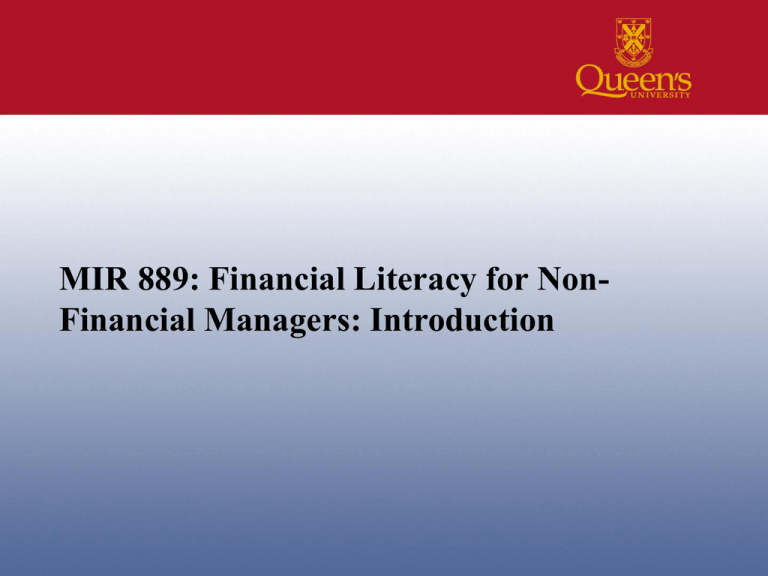
MIR 889: Financial Literacy for NonFinancial Managers: Introduction Today’s Session • Introductions: Around the room: who are you, your background, your expectations. • Relationship of Accounting to Business Strategy – Len • Financial Literacy: What is that? – Andy • Purposes of Accounting – Len • Users of Financial information – Len and Andy 2 3 Course Objectives • Familiarization with financial concepts • Comfort with discussing the financial aspects of the work • Demystify financial management • Leveraging financial literacy to get your job done. 4 About Us • Len Anderson • Andrew Graham 5 About You Tell us who you are, what your background is, what you aspire to on graduation and your expectations for this course. 6 About the Course: Approach to Learning • Classes will be active. Students will be asked to undertake the following tasks, as part of the learning and evaluation process: – Text reading, – Some assigned out-of-class exercise, – Class quiz, – Class case studies for discussion in group and feedback, – Reviews of annual reports and financial statements, – Group work and presentations (2), including a capstone final presentation, and – Written assignments. 7 About the Course: Text and Readings Accounting for Non-financial Manager, Third Edition, John Parkinson with Charles Draimin, Captus Press All other readings will be provided on the Moodle site in pdf format. 8 About the Course: Assignments For the Presentations, a marking rubric has been provided in the Outline. 9 About the Course: Architecture Shareholder Perspective • Foundations: The World and Language of Accounting Management Perspective • Applications: Budgets, Risk, Control and Performance 10 About the Course: The Flow Accounting Fundamentals Assessing Performance Financial Statements Analysing Financial Statements Risk and Control Business Planning Financial Reporting 11 12 Remember, there is no stupid question. 13 Establishing context Consider the following metaphor: what does it tell us about success in business? Nascar strategy 14 Fundamentally • Business success is about direction and traction • Accounting is a tool to help with direction setting and the measurement of traction 15 16 What is Financial Literacy? • Understand the lingo: – Some core terminology is essential. – However, much of this terminology may have nuanced meaning in the particular operating culture of one organization. • Read the Reports: – This is best translated as being an intelligent user of financial information, be it costing for policy design or cash forecasts for the first quarter of the fiscal year. 17 What is Financial Literacy? • Get Clarity: – This may mean asking dumb questions. – It may also mean pushing the point of understanding so that everyone is actually talking about the same thing. • Marry up Numbers on a Pages with What Happens at the Mission End of the Organization: – A financially literate manager can see the link – or insist that it be clearly stated – between what may be for some just a bunch of numbers and the policy and operational impact. 18 Not Just a Financially Literate Manager or HR/IR Advisor, but a Financially Literate Organizations • All managers do not need to be accountants • Being ready users of financial tools and information is great • If the company does not use these tools it will fail • Two-way street – financial people need to understand what you do 19 Are Finance and HR Oil and Water? Words to describe concerns of Finance and Human Resources 20 So being financially savvy is good for the company Finance Human Resources 21 22 Forecasting Controlling Financial Condition Analysis Costing Identifying, Assessing and Managing Risk Core FM Skills Communicating financial and program information 23 The textbook view of the Nascar lessons • Directional activities can be broken down into: – Attention directing – budgetary control, variance analysis, control triggers – Decision making – choices between alternatives, viability assessments, build/buy • Measurement of traction – Scorekeeping – Inherently a “rear view mirror” activity, stewardship reporting 24 Accounting serves all three purposes dynamically Decision making Strategy Scorekeeping Attention directing 25 Consider one strategy model • Michael Porter “Competitive Advantage” • Cost Leadership v Differentiation • Exercise – identify two businesses in each of the following sectors that each embody one of Porter’s strategy focus points: • Airlines • Grocery stores • Hotels 26 The management perspective • Now ask yourselves • What would you expect these businesses to look like in a financial statement? • Think: sales volumes, profit margins, number and cost of people, investment in physical infrastructure • What would be important to management? • And what financial information would they focus on 27 28 Users and uses • In groups, read the tabletop cases handed out • Take 15 minutes for reading and discussing in your groups • Tabulate the following: • Who are the likely users of the financial statements in each case? • For which of the three purposes do they seek information ? • How do they get the information? 29 Wrap up • Questions? • Homework – read Parkinson Chapters 2, 4 and 5 including appendix 4.1 30
